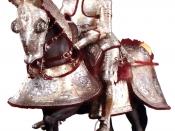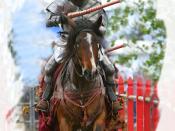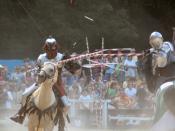Jousting was all about the skillful use of the lance while riding a fast moving horse. This was in recognition of the mounted knights most formidable weapon, the massed charge of lance equipped armored horsemen. It was this tactic that had defeated the Roman legions, Viking raiders, and just about every foe encountered. These charges sometimes failed, but that was rare. Anyone on the receiving end of these attacks could simply count themselves lucky if they survived. Until the 11th century, knights used their spears like swords, for thrusting, not as what we now think of as lancers. The joust was an idealized form of knightly combat that rarely occurred on the battlefield. In a joust, two knights charged each other, armed with a lance, the object being to use the lance to unhorse one's opponent. No doubt this event became the premier tournament event because of the dramatic effect of two mounted knights in full armor charging each other at full speed.
The earliest tournament jousts simply had two groups of knights chase each other over an open area, called the lists, attempting to unhorse each other with a lance, sword, simply fancy riding. The lists covered an area that might be as large as several hundred acres, and the joust might involve over a hundred knights on each side. This was a very rough game. Deaths were common and ten percent or more of the participants might be injured. During this period, knights began to wear additional padding under their armor as protection from the blows from blunted swords and the falls from their horses. During the 12th century, it became more common to have knights go one on one in jousts. These were pretty simple affairs. The two knights, separated by 100-300 yards of open space,


